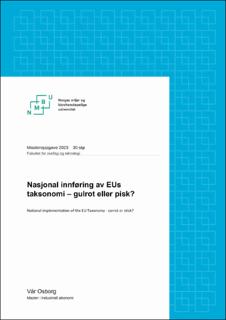| dc.contributor.advisor | Arnkell Jonas Petersen | |
| dc.contributor.advisor | Efthymia Ratsou Stæhr | |
| dc.contributor.author | Osborg, Vår | |
| dc.date.accessioned | 2024-04-10T16:27:36Z | |
| dc.date.available | 2024-04-10T16:27:36Z | |
| dc.date.issued | 2023 | |
| dc.identifier | no.nmbu:wiseflow:6780174:53392112 | |
| dc.identifier.uri | https://hdl.handle.net/11250/3125892 | |
| dc.description.abstract | EU har etablert en handlingsplan for bærekraftig finansiering med mål om klimanøytralitet innen 2050. Hjørnesteinen i denne planen er innføringen av EUs taksonomi, et klassifiseringssystem som har som mål å utvikle en felles europeisk definisjon for hva som er bærekraftige aktiviteter. Bygg- og eiendomsbransjen er bransjen med høyest utslipp og står for omtrent 40 prosent av energiforbruket og 36 prosent av klimagassutslippene i EU (SINTEF Byggforsk, 2020). Derfor har EU publisert tekniske screeningkriterier som definerer bærekraftige aktiviteter i bygg- og eiendomsbransjen.
I denne oppgaven undersøkes ulike aspekter knyttet til innføring av EUs taksonomi i bygg- og eiendomsbransjen i Norge. Spesielt undersøkes det om innføringen av EUs taksonomi faktisk vil styre bygg- og eiendomsbransjen mot mer bærekraftige aktiviteter eller ikke.
Gjennom litteraturstudie, intervjuer med interessenter i bransjen og en case-studie, er det funnet ut at: (1) BREEAM-NOR v6.0, med noen få justeringer, kan dekke alle de tekniske kriteriene som er fremsatt i EUs taksonomi, og kan derfor brukes som en praktisk tilnærming til taksonomien i Norge. (2) Det gjenstår likevel noe arbeid før taksonomien kan implementeres fullt ut i Norge. Nøkkeldefinisjoner og standarder for energiytelse, NZEB og klimagassberegninger har ikke samsvar med EUs taksonomi, noe som hindrer bransjeaktører i å tilpasse seg taksonomien. Det er signalisert at det arbeides med å klargjøre disse definisjonene og standardene. (3) Det er fortsatt et kunnskapsgap blant entreprenører og tjenesteleverandører om hvordan man overholder EUs taksonomi, og hva kostnadene og fordelene er. Dette kunnskapsgapet hindrer enkelte deler av markedet i å engasjere seg i taksonomien. I tillegg stiller taksonomien strenge krav til bærekraftige bygg og dette medfører merkostnader i alle ledd. (4) Investorer kan forvente høyere leiekostnader, bedre låne- og forsikringsbetingelser, men disse vil ikke veie opp for kostnadene ved å bygge i henhold til taksonomien. Det er derfor avgjørende å sikre bedre betingelser og insentiver for aktører i bransjen hvis en nasjonal tolkning av EUs taksonomi i økt grad skal styre bygg- og eiendomsbransjen mot mer bærekraftige aktiviteter. | |
| dc.description.abstract | The EU has established a plan for sustainable financing with a goal of climate neutrality by 2050. The cornerstone of this plan is the introduction of the EU's taxonomy, a classification system aimed at developing a common European definition of what constitutes sustainable activities. The construction and real estate industry accounts for approximately 40% of energy consumption and 36% of greenhouse gas emissions in the EU (SINTEF Byggforsk, 2020). For this reason, EU has published technical screening criteria that define sustainable activities in the construction and real estate industry.
In this paper, various aspects related to the implementation of the EU's taxonomy in Norway as it regards the construction and real estate industry are investigated. Especially, it is examined whether an implementation of the EU's taxonomy in fact will guide the industry towards more sustainable activities or not.
Through literature study, interviews with stakeholders in the industry and a case study, it is found that: (1) With only minor revisions, BREEAM-NOR v6.0 can cover all the technical criteria put forth in the EU's taxonomy and may therefore be used to classify buildings in accordance with the EU's taxonomy in Norway. (2) Some work remains before the EU's taxonomy can be fully implemented in Norway. Key definitions and standards for energy performance, NZEB and greenhouse gas calculations do not comply with the EU's taxonomy, hindering industry actors from conforming to the taxonomy. It has been signaled that work is underway to clarify these definitions and standards. (3) A knowledge gap still remains among contractors and service providers regarding how to conform to the EU taxonomy, and what the costs and benefits are. This knowledge gap hinders some parts of the market from engaging with the taxonomy. The taxonomy imposes strict requirements for sustainable buildings, which results in additional costs at all levels of the building process. (4) While investors in taxonomy-classified projects can expect higher rental income, lower maintenance costs and better loan and insurance conditions, these advantages will not offset the costs of building according to the taxonomy. It is therefore crucial to secure better conditions and incentives for building in accordance with BREEAM-NOR v6.0, if the goal of incentivizing the industry to partake in more sustainable activities. | |
| dc.language | nob | |
| dc.publisher | Norwegian University of Life Sciences | |
| dc.title | Nasjonal innføring av EUs taksonomi – gulrot eller pisk? | |
| dc.type | Master thesis | |
